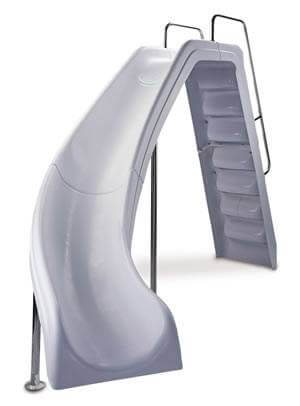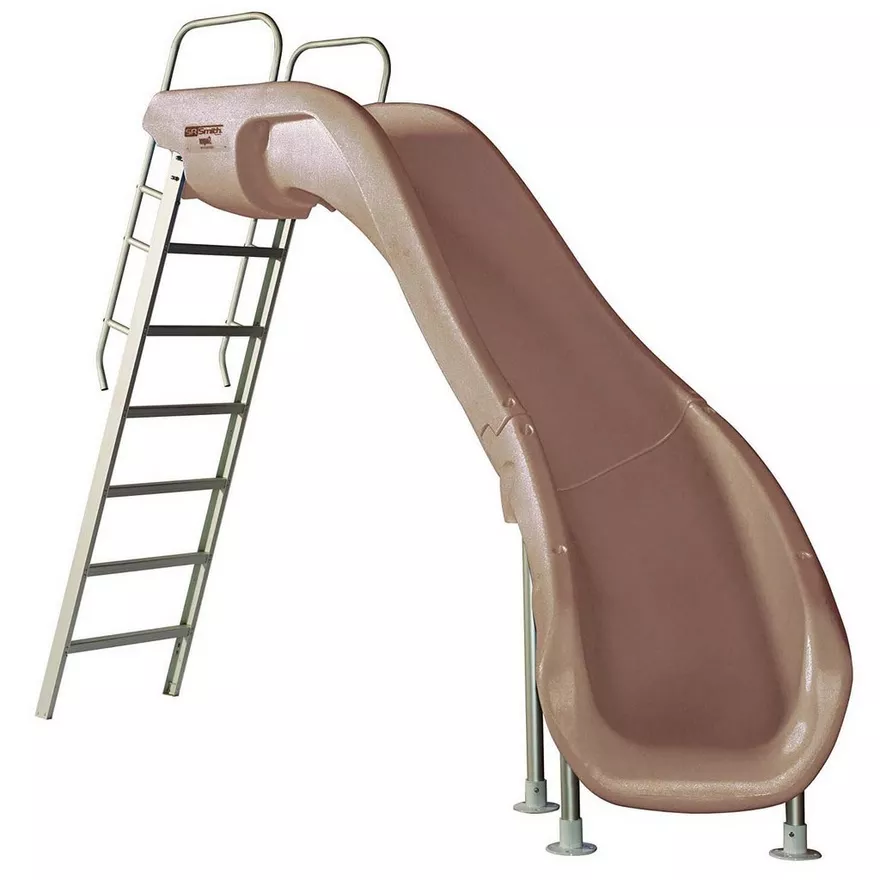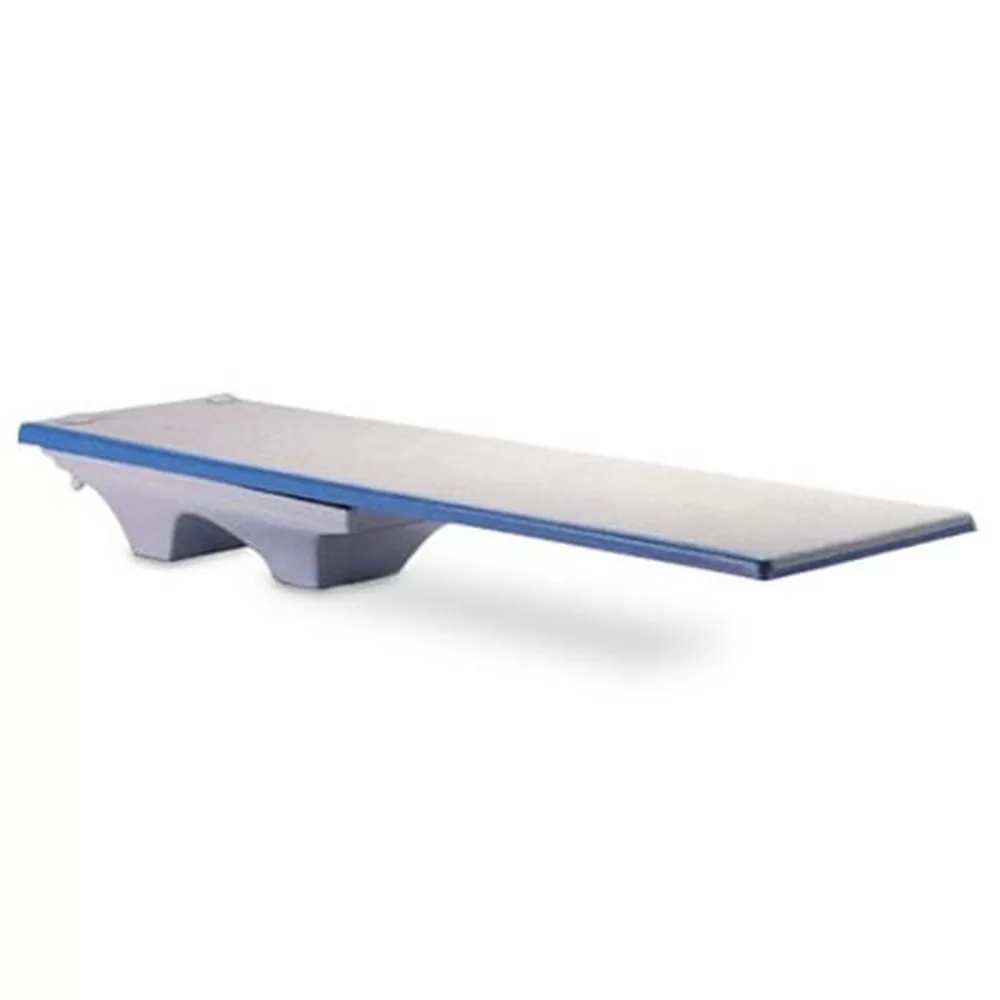
Pool Slides are loads of fun, always ready for action. Since they are not mechanical, we don’t often think of maintenance or repair issues – but they do exist.
In the last ten years, pool slide construction materials have changed, and this has led to presumably less maintenance or repair issues.
For instance, slides are no longer made from a fiberglass shell, with a thin gelcoat surface. Rotomolded polyethylene, or thermoplastic acrylic surfaces are used nowadays, with the color all the way through. And ladders are different too – gone are the flimsy aluminum legs, most slides now have a closed ladder design, which not only looks better, but is safer too.
Nonetheless, even these new style pool slides will need cleaning, maintenance and repairs. And, there are thousands of older pool slides installed in America, in need of some tender loving care.
So then – here’s a short article on how to clean and maintain a pool slide, and some information on making some common pool slide repairs on your own.
Pool Slide Cleaning
Cleaning a pool slide is needed every few months to keep the original luster of your pool slide. Ladder treads and the top of the slide deck can catch dust and dirt, held fast by air borne oils and pollutants. Hair products, skin lotion and tanning oil residues can be left behind by users, and your slide could become the occassional target for birds flying overhead. The slide legs, which can be powder coated steel or aluminum, can develop scale or rust on the surfaces or around nuts, bolts and flanges.
Pool slides get dirty – and need at least an annual cleaning.
For all surfaces, if you clean it often, you will only need to use a small amount of dish soap and a soft cloth. For a deeper cleaning, you can gently use a granulated chlorine powder (not pool shock!), like Bon Ami or Clorox powder. Be careful not to scrub too hard, and use only a soft cloth. Windex (Ammonia) can be used to bring a polish or quick wipe downs. You also can use Formula 409 or Fantastik cleaners.

Don’t use abrasive scrubbing pads, and don’t use vinegar, Lysol, Pinesol, or other general purpose cleaners or disinfectants to clean a pool slide. Whichever cleaner you use, don’t use too much, to keep the residue from getting into the pool. Some cleaners contain phosphates and nitrates that are best kept out of your pool.
Steel or Aluminum ladders and legs can be cleaned with the same cleaner, and rinsed onto the pool deck. Often, a quick wipe with a soft clean cloth and some windex is all that’s needed. Use Bon Ami for scale build-up on aluminum.
For saltwater pools, indoor pools or pools by the ocean, it is recommended that the slide surfaces be rinsed daily to remove salt buildup. Cleaning schedules should be accelerated too, to keep the slide looking good.
Rinse slide well, then tape a heavy plastic trash bag onto the bottom of the slide, to catch soapy rinse water. Bonus tip – empty the bag before it gets too full!
Pool Slide Maintenance
Once per year, make a pool slide inspection – for safety and maintenance.
- Check tightness on all bolts, and inspect closely for any problems.
- Check the water supply system for leaks or worn components.
- Check that warning labels are still readable, not torn or faded.
- Check ladder treads for any sign of wear, yield or fatigue.
- Check the slide surfaces for any cracks or chips.
- Check the bolts and nuts for any scale or rust.
- Climb the ladder and inspect it top-side.
- Check water supply jet direction.
Pool Slide Repairs
- Surface Scratches – Very light scratches, scuff marks and haze can be hand polished with Permatex Plastic Cleaner or Gel-Glass. Follow the manufacturer’s guidelines. Clean cotton cloth works best for applying the polish and buffing. Turtle Wax white polishing compound can also be used for deeper scuffs and scratches.
- Surface Cracks – Newer rotomolded and acrylic slides rarely crack, but if they do, it can be fixed. It requires a plastic welder and PE plastic which can be purchased in flat rods. After preparation, new material of a similar color is melted into the crack, sanded and polished. Fiberglass slide cracks are more common. It can be small stress cracks in the Gelcoat surface, or in rare cases, the fiberglass shell itself can become cracked. Gelcoat repair kits can be purchased, or your slide could be completely recoated, by a local boat repair company. Fiberglass repair kits are also available, commonly sold for fiberglass boat hull or car panel repairs.
- Ladder & Legs – For steel legs, (used on the larger pool slides) if rust develops around bolts or flanges, it should be sanded and touched up iwith Rustoleum. Matching paint can be purchased from the manufacturer. Steps or treads that show any sign of stress, or are bent or bowed should be replaced. Replace any stripped broken or loose bolts or deck lags. It’s recommended to use only hardware from the original manufacturer.
 Water Supply Issues – Modern slides no longer use the skinny 1/4 inch diameter hose and those tiny jets. New slides may have a 1 inch pipe, which rarely requires replacement. Jet nozzles may clog in areas of hard water, and may need to be reamed clean. Connection gaskets will need replacement at some point, as will the valve that turns on the water to the slide. Older slides can purchase a complete slide hose / parts kit to replace the 1/4 inch hose, gaskets and slide jets.
Water Supply Issues – Modern slides no longer use the skinny 1/4 inch diameter hose and those tiny jets. New slides may have a 1 inch pipe, which rarely requires replacement. Jet nozzles may clog in areas of hard water, and may need to be reamed clean. Connection gaskets will need replacement at some point, as will the valve that turns on the water to the slide. Older slides can purchase a complete slide hose / parts kit to replace the 1/4 inch hose, gaskets and slide jets.
Remember that pool slides have a weight limit of 200-275 lbs. Exceed this limit and the slide could become damaged, or the slider could become injured. For more on safe and intended use of your pool slide, please see the owner’s manual.





